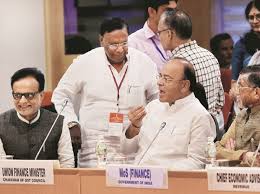Amid a sense of doom and gloom spread by the falling rupee, rising oil prices and widening current account deficit, the government has at least one reason to cheer: compensation due to state governments for loss of revenue stemming from introduction of the goods and services tax (GST) in July 2017 is dropping sharply. Latest calculations by the ministry of finance show the shortfall in revenue of states because of GST, or compensation due to the states from the Centre, stands at around Rs 4,500 crore a month on an average against the Rs 5,300 crore paid in the same period last year, officials with knowledge of the matter said.
Last year, when India moved to the one-nation-one-tax regime, the Centre promised to compensate individual states for any loss of revenue from the introduction of GST, which subsumed a raft of indirect levies.
North Block is in the process of completing an exercise to calculate the amount due to states. The figures are startling. Compared to Rs 48,000 crore paid last year (for the period from July 1, 2017, to March 31, 2018) to states as compensation for revenue loss, this year (April to July) the Centre has had to pay about Rs 18,000 crore, or Rs 4,500 crore, a month.
“The gap — shortfall in revenue of states — is likely to reduce even more in the days to come,” an official involved in the process said, asking not to be identified.
The improvement is an indication of a widening tax base and that the initial glitches in implementing the indirect tax regime are behind the government.
Additional steps to boost revenue collection may lead the shortfall to narrow further.
“The inherent characteristic of GST is that it would result in tax buoyancy. This buoyancy would not only come from widening of the tax base but also from imported compliance and competitiveness of trade and industry. So, therefore, it would be but natural to expect the requirement of compensation to States for loss of revenue going down from year to year,” Shaktikanta Das, the former Union economic affairs and revenue secretary and member of the 15 Finance Commission, said.
Among other things, the introduction of electronic way-bills (e-way-bills) — an electronic documentation detailing the movement of goods above a certain amount — has led to increased transparency and better collections.
Documents prepared by the GST Council, which is overseeing the implementation of the indirect tax regime, reveal that the number of entities filing tax returns has slowly grown.
In December 2017, about 66% of the entities enrolled under the regime filed their returns. Subsequently, the numbers dipped. For July, 2018, however, 68% of entities had filed their tax returns.
“The compensation amount has reduced due to better implementation, widening of tax base and better implementation. It has resulted in better revenue collection. It is expected that state governments will take more steps to boost their revenue collection further which would further reduce the amount compensation from the centre in the near future,” additional director general (media and communication), DS Malik, said.
Source: Hindustan Times
We have launched Single Platform on GST Compliances In India, assisting in 4 areas – 1) Compliances, 2) Litigations & Hearings, 3) Training 4) Consultancy. Click this link for any assistance.
 customersuccess@taxmantra.com
customersuccess@taxmantra.com Toll Free:
Toll Free:  Contact Us
Contact Us


